Pozolillo Verde
From the cookbook "Dining with the Dead: A Feast for the Souls on Day of the Dead"
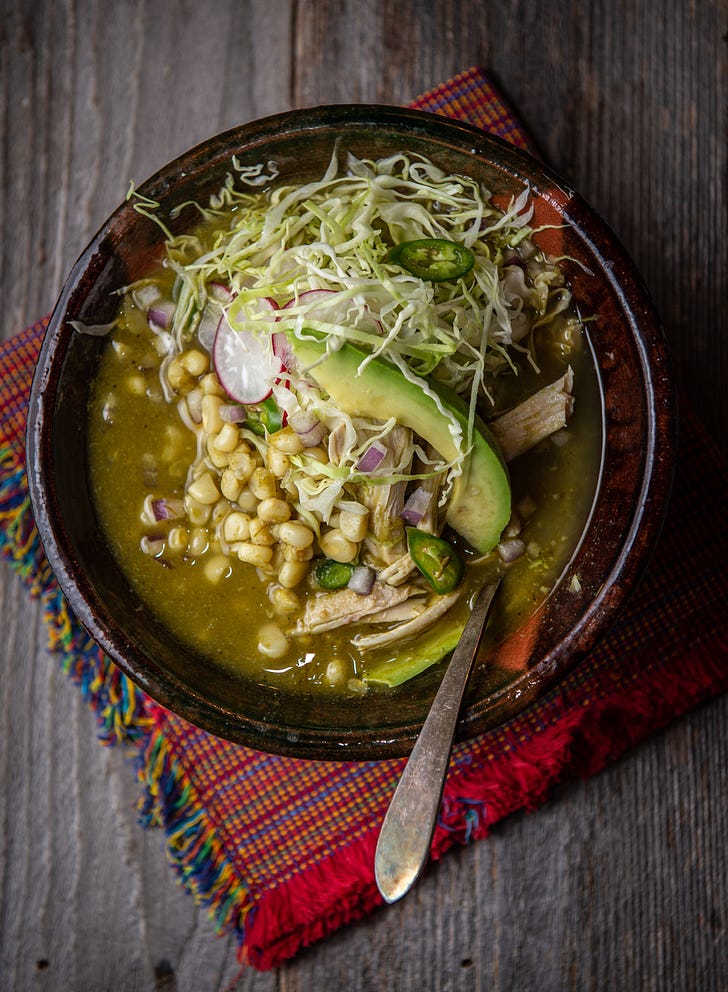
When I first laid eyes on Dining with the Dead by Mariana Nuño Ruiz and Ian McEnroe around this time last year, I knew I just had to have it. As I’m sure you know, publishers send me lots of cookbooks, but this one I bought. And that wasn’t easy, as it was sold out everywhere. I finally found it at Book Larder in Seattle. The thrill of the hunt made me want it even more. When it arrived, I paged through and mentally bookmarked many recipes. This is the kind of book that goes deep on traditional techniques, so you can build a foundation of knowledge — and a pantry.
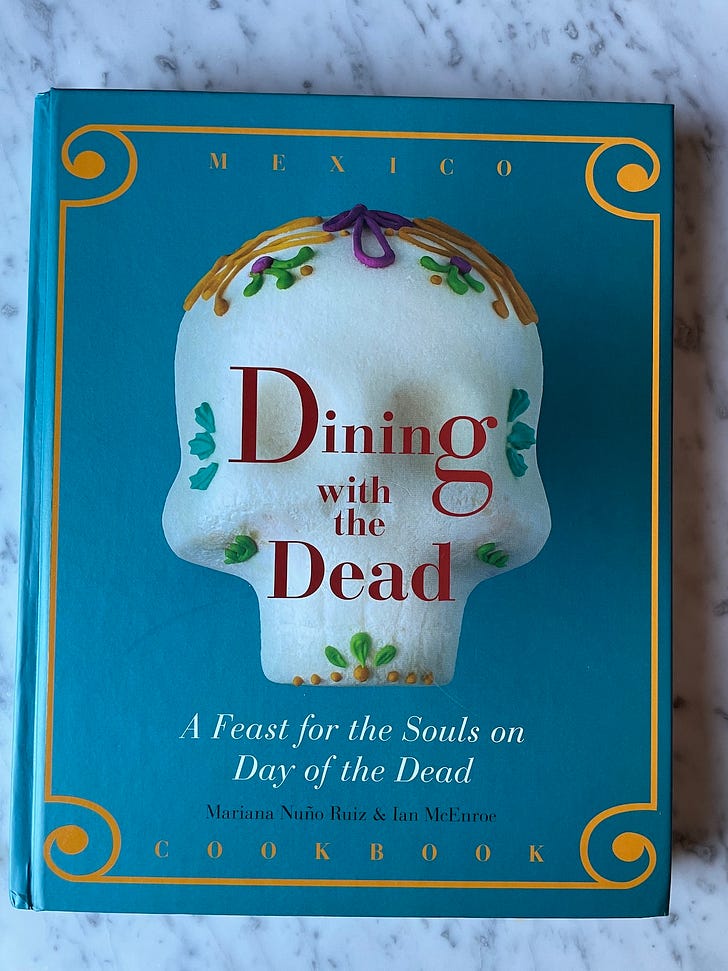
Given the year I’ve had, which has been kinda busy, I didn’t actually get around to cooking from the book until this week. And as Day of the Dead approaches, I thought it would be a good time to share this book with you and a pozole recipe from it. I have made “pozole” — a traditional Mexican stew that typically contains hominy and meat — before, but now I have been educated, thanks to Mariana.
The recipe I’m sharing with you today — Pozolillo Verde — is the easiest (and lightest) of the FIVE pozole recipes in the book, because it uses fresh corn (which I got the last of at my farmstand just yesterday!) rather than freshly cooked hominy, which is a more involved process.
When I asked Mariana if I could use canned hominy as a substitute in this recipe, this was her response, and I quote:
Noooo! Please, canned hominy is horrible, it tastes like canned potatoes, not even remotely of what hominy tastes.
She went on to explain that pozolillo — meaning “little pozole” in Spanish — is specifically made with fresh corn, and that if you use hominy, it becomes a version of pozole verde. In other words, a different recipe altogether!
Consider me schooled. So I went deeper into the text and turned to page 69, on “How to make Nixtamal,” which was so well explained, I am now eager to make it. Nixtamalization is the process of removing the skin from dried corn so it can be made into hominy (for pozole), ground fresh into masa for tortillas or tamales, or dried again and ground into masa harina. “Corn is the backbone of a cuisine that feeds the living and honors the dead” — they write in the book — so its importance to Mexican cooking cannot be understated.

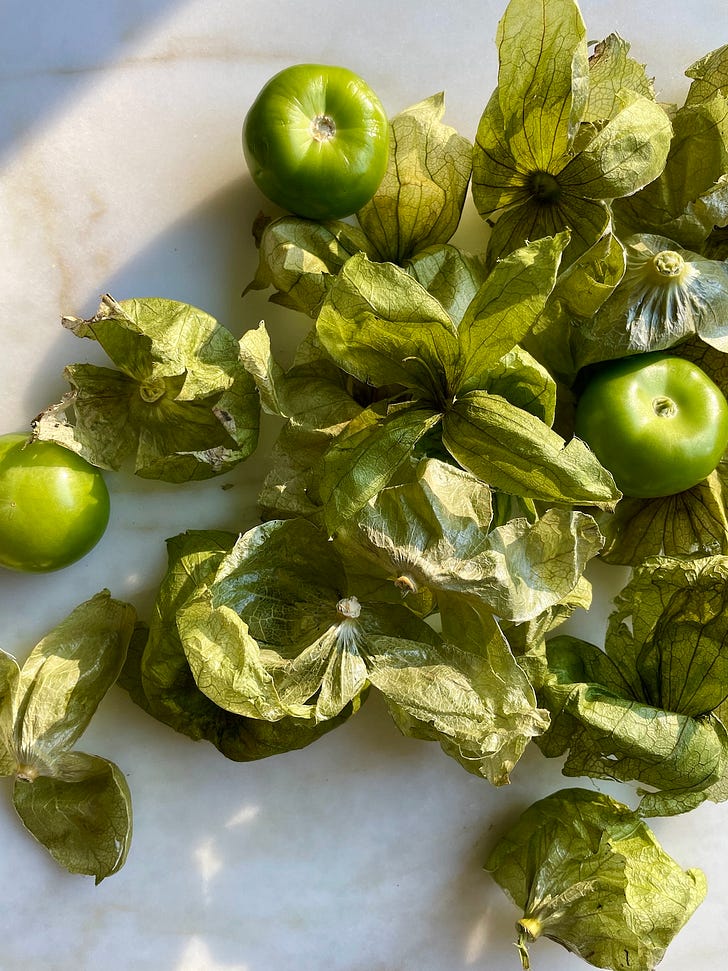
I stopped by my local Latin American grocer to see if I could find what I needed to make the Nixtamal (for next time). I did get the “cal,” aka calcium hydroxide, that I will need, and I’m still looking for just the right corn. At a later date, we will get back to this experiment — let me know if you’re interested in seeing how it turns out!
Dining with the Dead is more than just a cookbook — it is packed with history and facts and origin stories about Day of the Dead, with lots of photos of Day of the Dead rituals. There are even craft projects — like making and decorating sugar skulls and making paper flowers — as well as a chapter on cocktails, and another on hot drinks. Other chapters explore Antojitos (Mexican Street food), Moles, Tamales, Salsas, Quick Pickling and Escabeches, Street Snacks, Aguas Frescas, Sweet Tamales, Pan Dulce, and more.


It’s difficult for me to paraphrase from this book, so I will just go ahead and quote directly to give you a better idea of what it is all about.
On Day of the Dead origins:
“On the first and second days of November, Mexicans celebrate and remember their dead by welcoming their traveling souls. This social tradition is an important part of family life, identity, religion, history, and culture. The evolution of Dia de Muertos into the cultural folk tradition of today has deep roots in Mexico’s past.”
On the subject of Day of the Dead in Mexico today:
“The Dia de Muertos celebration has become one of Mexico's most cherished and iconic traditions and a holiday that celebrates our Mexican roots through our ancestors. The holiday has become secularized in some areas, while in others it remains deeply rooted in Catholicism, but it is still All Saints' Day and All Souls' Day in Mexico. Regardless of its complex origins, it is ultimately a holiday that simultaneously provides a sobering reminder of mortality while joyfully comforting the living as they memorialize the dead.
During the celebration, which starts on October 31 and spans November 1 and 2, people honor their dead with music, food, and religious folk rituals. Once a year on these nights, the souls or ‘ánimas’ of our beloved departed ones, those who, as we say in Mexico, are ‘ahead of us,’ return to commune with the living relatives and to enjoy the pleasures that made them happy in life: food, drinks, music, laughter, stories, and the warm company of family and friends. The living gather in cemeteries, churches, and at home to prepare welcoming feasts and celebrations to make the souls' long journeys worthwhile.
Despite sharing almost the same date as Halloween, Mexico's Day of the Dead shares little meaning with that commercial, sometimes macabre holiday. Celebrating with the dead in Mexico is not a morbid affair; the welcoming of their souls is always joyful!”
I loved getting a deeper understanding of this important Mexican tradition through this incredibly well researched book. It was a labor of love for Mariana and Ian, and many years in the making. I’ve always been a lover of Mexican cuisine and culture, and this excellent book will be getting a lot of use as I explore it further, using Dining with the Dead as my guide.
The book is loaded with beautiful photography, including step-by-steps, as well as sourcing info, equipment, ingredients, etc.
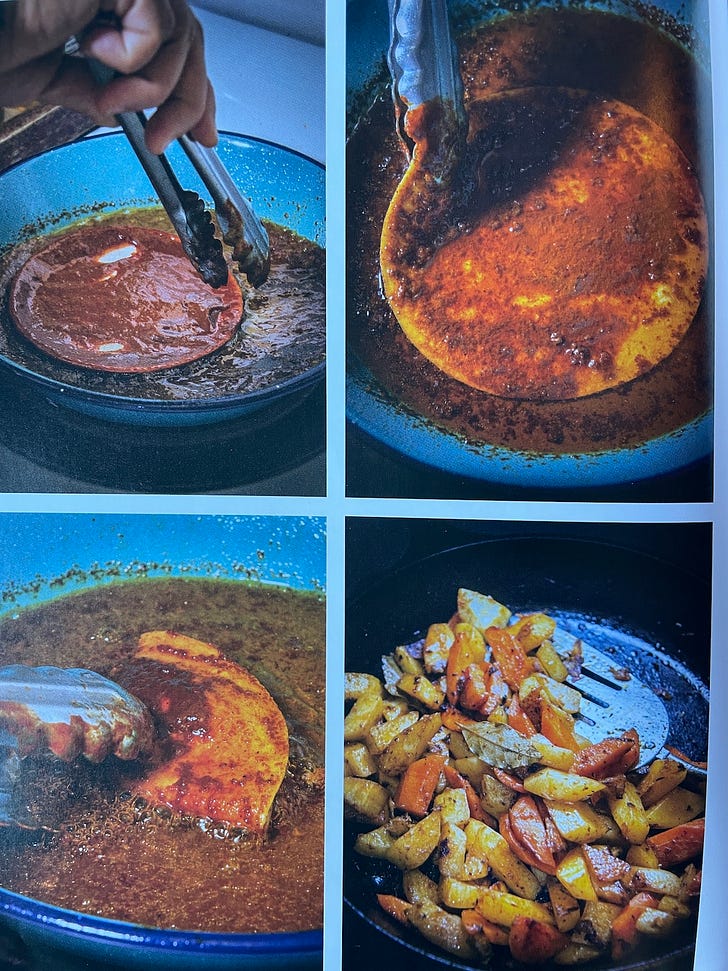
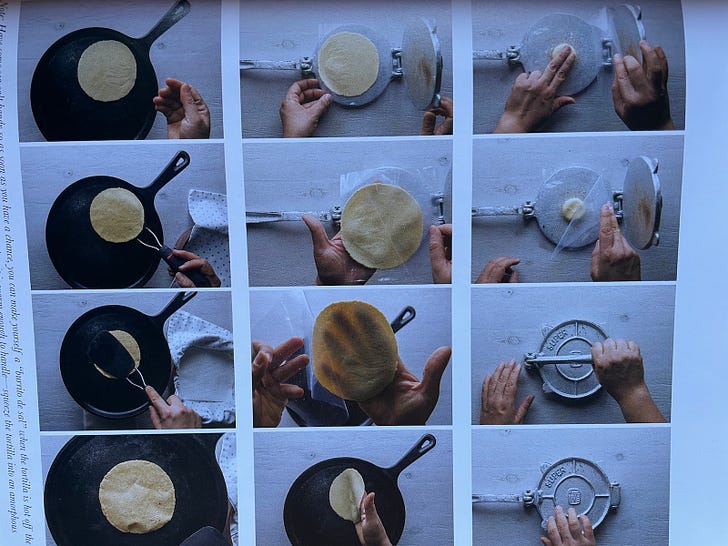
Thank you, Mariana and Ian, for sharing this recipe today, and for creating this incredible book.
You probably won't find Dining with the Dead on Amazon, so order instead from Book Larder, Now Serving, or directly from the publisher, Rio Nuevo books.
Cookie season is fast approaching! If you want all of this year’s new cookie content to land in your inbox, consider upgrading to a paid subscription (you’ll also gain access to the previous two holiday seasons’ worth of recipes and my Great Big Cookie Guide). As a reader-supported publication, every subscription is appreciated and helps fund the butter budget for creating new content!
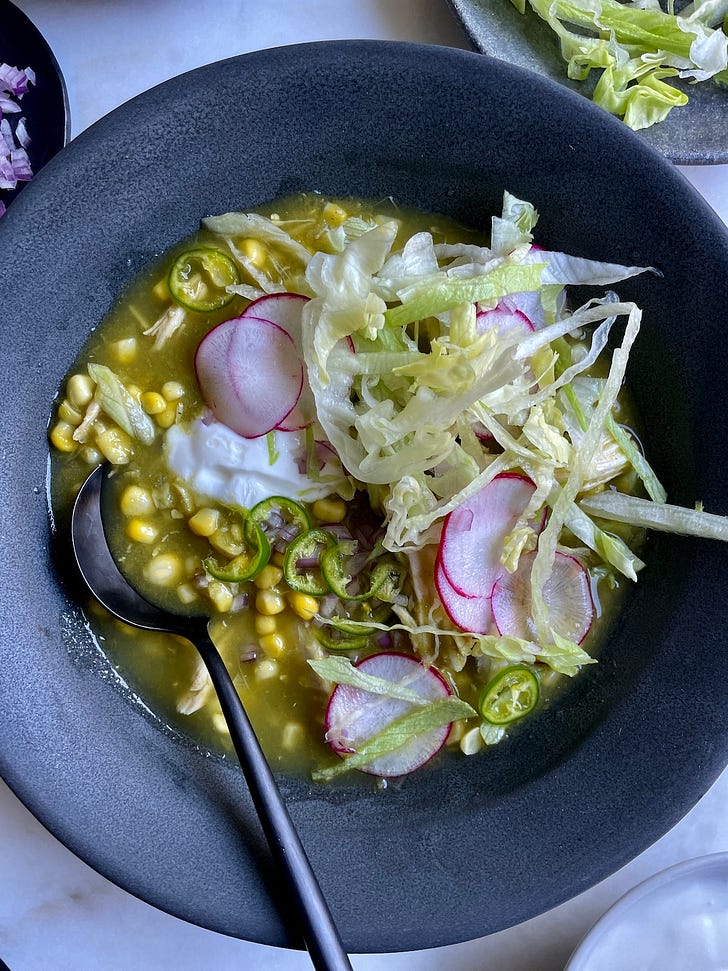
Pozolillo Verde
Green Pozolillo
From Dining with the Dead by Mariana Nuño Ruiz and Ian McEnroe
Serves 4 to 6
I fell in love the first time I tried this pozolillo. This dish got is diminutive name pozolillo, meaning "little pozole," due to its easy, hour-and-a-half preparation. This fresher, lighter pozole is made with fresh white corn kernels sliced off the ear, rather than dry nixtamalized corn cooked into hominy. It is usually made with pork, but I often make it with chicken for a lighter broth.
Adding green tomatillos to the broth gives it a bright-green color and a pleasant, fresh, tangy flavor. It is best to prepare this kind of pozole at the beginning of corn season when the corn is tender and fresh. At home, this is one of our favorites.
Chicken stock:
12 cups water
½ medium white onion
½ head of garlic
½ bunch of cilantro
3 sprigs fresh mint
2 bay leaves
½ teaspoon dry oregano
½ teaspoon dry thyme
2 carrots
1 celery stalk
2 teaspoons sea salt
4 to 4½ pounds whole chicken, skin on, cut in half or pieces
Green sauce:
2 pounds green tomatillos, husks removed and rinsed
3 large poblano peppers, stems and seeds removed, coarsely chopped
½ medium white onion
4 cloves garlic
1 large bunch fresh cilantro
½ teaspoon Mexican dry oregano
2 teaspoons sea salt
2 to 3 serrano peppers
2 tablespoons corn or safflower oil
10 to 12 ears of white corn, dekerneled
Garnish:
1 head iceberg lettuce or green cabbage, finely shredded
1 large red onion, finely diced
1 bunch of red radishes, thinly sliced
1 to 2 avocados, sliced
4 to 6 limes, cut in quarters ½ pound Mexican crema ½ pound queso fresco, crumbled
Corn tostadas
Make the pozole:
In a large pot, add 12 cups of water, onion, garlic, cilantro, mint, bay leaves, oregano, thyme, carrots, celery, and sea salt. Add the chicken. Bring to a boil, cook for 5 minutes, then reduce heat to a slow simmer. With a ladle, remove all the white foam that forms as it cooks. Cook for about 40 to 50 minutes, until chicken is tender. Once the chicken is cooked, remove the chicken and aromatics and vegetables and sieve the broth. Let the chicken cool down until it reaches a comfortable temperature. Remove and discard the skin and shred the chicken. Set aside.
In a blender, add the tomatillos, poblano peppers, onion, garlic, cilantro, oregano, salt, and one serrano pepper. Add one serrano at a time and taste in between blending so you can measure how spicy it is. The serranos in this recipe are used to add flavor, not heat, as one would season with black pepper. Add a ladle of the chicken stock from the pot to help with the blending. Blend to a smooth puree.
In a large, deep pot add 2 tablespoons of cooking oil and warm over medium-high heat until oil is shimmering. Add the blended tomatillo sauce to the oil and cook for 5 minutes. (Note: Introducing the sauce to the hot oil will cause it to splatter; keep your hands and arms away by using a long-handled ladle to avoid burns.) After the sauce is sautéed, add the chicken stock and the corn kernels. Bring to a slow simmer and cook for about 25 to 30 minutes. The broth will change color from emerald green to a bright sage green. At this point taste to adjust for salt. Add the shredded chicken to warm through.
Serve piping hot and garnish with shredded lettuce, chopped onions, slices of radishes and avocado, a squeeze of lime, a dollop of crema, crumbled queso fresco, and tostadas.
NOTE: If you want a shortcut to recipe preparation, use pre-made chicken stock (in equal amounts to the water), and a prepared rotisserie chicken, shredded.
SUSAN’S RECIPE NOTE: I held back 3 cups of the stock to avoid thinning the soup too much. The yield on the stock can vary depending on how much evaporation occurs. I saved it for my next pozole! Also, I found the recipe to yield more than 6 servings, so it’s a good recipe to stock your freezer with leftovers of. I got more than a gallon of soup, enough for a party!

Newsletter editor: Molly Ramsey




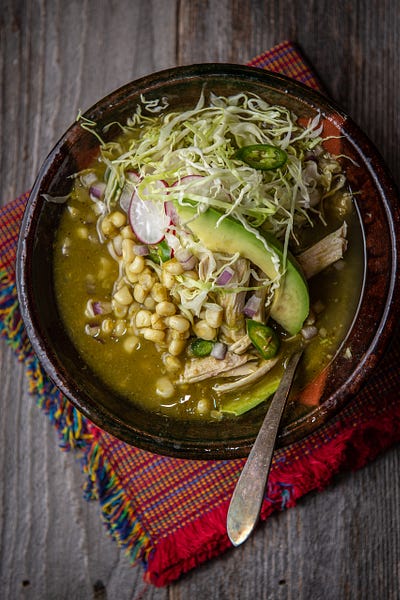
Sounds delicious!
I loved this post so much. I made nixtamal a couple of times using cal. It’s not difficult per say but it requires a lot of patience and a bit of dirty work. I had always been confused with what that was actually called but come to think of it I did make nixtamal. I prepped it a day before making a giant batch of pozole and the taste was incredible. Im inspired now to search this book and make it again. A book I’ve been very into also that has a lot of information about this subject is also the book Masa.